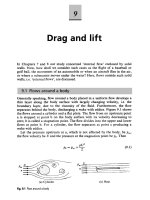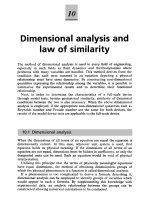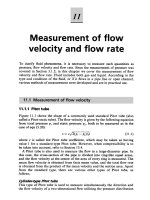Introduction to Fracture Mechanics phần 1 ppsx
Bạn đang xem bản rút gọn của tài liệu. Xem và tải ngay bản đầy đủ của tài liệu tại đây (222.17 KB, 10 trang )
Introduction to Fracture Mechanics
1
Introduction to Fracture Mechanics
From Suresh: Fatigue of Materials
INTRODUCTION
Importance of Fracture Mechanics :
All real materials contain defects: understand
the influence of these defects on the strength of
the material.
Defect
-
tolerant design
philosophy.
2
the material.
Defect
-
tolerant design
philosophy.
Relevance for Fatigue: understand the initiation
and growth of fatigue cracks.
We will use two approaches, an energy-based
approach and a more rigorous mechanics approach.
Key Idea : Griffith (1921) postulated that for unit
crack extension to occur under the influence of the
applied stress, the
decrease
in potential energy of
Griffith Fracture Theory
Introduction
3
applied stress, the
decrease
in potential energy of
the system, by virtue of the displacement of the
outer boundaries and the change in the stored elastic
energy, must equal the
increase in surface energy
due to crack extension.
Consider the center-cracked plate shown below.
The in-plane dimensions of the plate are large
compared to the crack length.
4
Using the results of Inglis (1913) Griffith found that
the net change in potential energy of the plate caused
by the introduction of the crack is:
.
'
22
E
Ba
W
P
'
E
E
5
= E Plane stress
The surface energy of the crack system is
2
1
'
v
E
E
sS
aBW
4
Plane strain
where γ
S
is the free surface energy per unit surface area.
The total system energy is then given by
.4
'
22
SSP
aB
E
Ba
WWU
6
Griffith noted that the critical condition for the onset
of crack growth is:
,02
'
2
S
S
P
E
a
dA
dW
dA
dW
dA
dU
where A=2aB is the crack area and dA denotes an
incremental increase in the crack area.
Thus the stress required to initiate fracture is:
.
'2
a
E
S
f
7
a
As the second derivative, d
2
U/da
2
is negative, the
above equilibrium condition gives rise to
unstable
crack propagation. This applies for brittle materials;
it must be modified for ductile materials such as metals.
Orowan (1952) extended Griffith’s brittle fracture
concept to metals by simply adding a term representing
plastic energy dissipation. The resultant expression
for fracture initiation is
,
)('2E
p
s
8
,
a
p
s
f
where is the plastic work per unit area of surface
created. Generally is much larger than
p
.
s
p
Energy Release Rate
Crack Driving Force
Consider an elastic plate with an edge crack of length
as shown below:
,
a
9
The total mechanical potential energy of a cracked
elastic body is given by the general expression
FP
wW
where is the stored elastic strain energy and is
F
w
10
the work done by the external forces.
F
Irwin (1956) proposed an approach for the
characterization of the driving force for fracture in
cracked bodies, which is conceptually equivalent to
that of the Griffith model.









